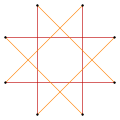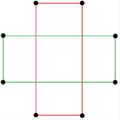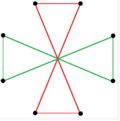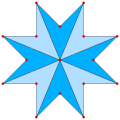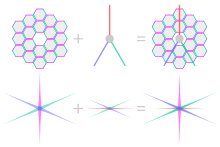| Regular octagram | |
|---|---|
 A regular octagram | |
| Type | Regular star polygon |
| Edges and vertices | 8 |
| Schläfli symbol | {8/3} t{4/3} |
| Coxeter–Dynkin diagrams | |
| Symmetry group | Dihedral (D8) |
| Internal angle (degrees) | 45° |
| Properties | star, cyclic, equilateral, isogonal, isotoxal |
| Dual polygon | self |
| Star polygons |
|---|
In geometry, an octagram is an eight-angled star polygon.
Contents
- Detail
- Variations
- As a quasitruncated square
- Star polygon compounds
- Other presentations of an octagonal star
- Other uses
- See also
- References
- External links
The name octagram combine a Greek numeral prefix, octa- , with the Greek suffix -gram . The -gram suffix derives from γραμμή (grammḗ) meaning "line". [1]












